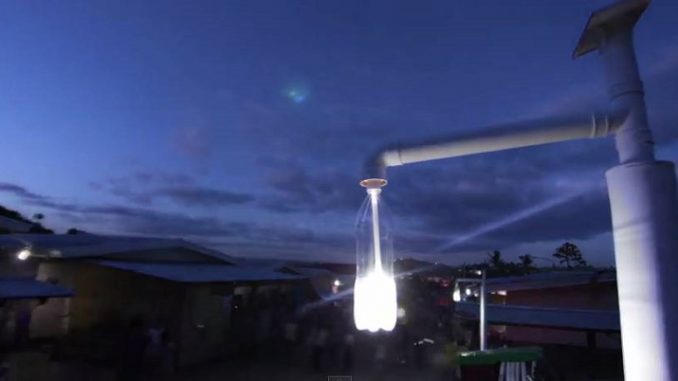
By Mukesh Ranjan
Initially, 22 primitive tribal households were chosen as beneficiaries for the ‘Liter of Light’ at Chano block in Ranchi and it was found that though it served well during the day
RANCHI: In a unique initiative taken by District Administration in Ranchi, women of Self Help Group (SHG) will be trained to lighten the lives of rural villages in the district by producing portable room lights, designed and developed by the students of Indian Institute of Technology (IIT), presently undergoing internship with the district administration.
The concept is basically adopted from ‘Liter of Light’ of Philippines.’Liter of Light programme,’ created by My Shelter Foundation for providing poor communities a cheap source of lighting that can be produced and distributed locally. Recycled plastic bottles filled with water and a bit of bleach are fitted into the roof to provide lighting during the day and can be upgraded with an LED bulb, micro-solar panels and a battery to provide a low cost night lighting system.
Initially, 22 primitive tribal households were chosen as beneficiaries for the ‘Liter of Light’ at Chano block in Ranchi and it was found that though it served well during the day, however, it was more important to have illumination in the house during night.
“As adequate light and ventilation is found rural households in Jharkhand, the ‘Light of Liter – 2.0’ was further modified by attaching a battery and a solar panel making it suitable for night as portable room light. IIT students, undergoing internship in Jharkhand, have developed a state of the art ‘solar bottle’ using discarded plastic bottles and putting some chemicals in it, which has been lightening the lives of rural people in State,” said DC Rai Mahimapat Ray.
It was designed and fabricated in 36 hours using rudimentary and locally sourced tools and components at a cost of Rs.110, he added. Notably, the concept was also applauded by Prime Minister Narendra Modi during his visit to Ranchi on May 25 during the special review meeting with Deputy Commissioner of Ranchi.
“Now the District Administration plans to install a Liter of Light – 2.0 in all the toilets built under ‘Swachh Bharat Mission.’ The solar bottles would be made available at all Pragya Kendra in the District providing a ready retail chain,” said the DC.
The Ranchi District administration and Jharkhand State Livelihood Promotion Society (JSLPS) have tied up to create a chain of master trainers who would train local SHGs from other districts which would help in promotion of the Liter of Light across the state.
“Mass production is envisaged by local Women Self Help Groups which will also provide sustainable livelihood to rural women while inculcating a spirit of entrepreneurship in the villages. It will also promote ‘Make in India’ as all the raw materials would be locally sourced,” said BITs Pilani graduate G M Sai Rama, pursuing fellowship under the DC Ranchi and associated with the programme.
As of now 33 prototypes have been distributed at Barihatu village in Bundu Block on a pilot basis. A total of 20 interns have been hired by District Rural Development Authority for a period of 2 months to work in villages as village fellows who would interact with villagers, see how the schemes are working and support the BDOs regarding work in the ground. Out of 20 interns, seven are from IITs. Rama further added that initially the idea was to promote ‘Swachha Bharat Abhiyaan’ as most of the people in rural areas prefer to defecate in the open because there is no light there and are located at a distance from the house but eventually it was felt that it could also be used as a source of light for around 4-5 hours in the house on 7-8 hours of charging.
Source: The New Indian Express

Leave a Reply